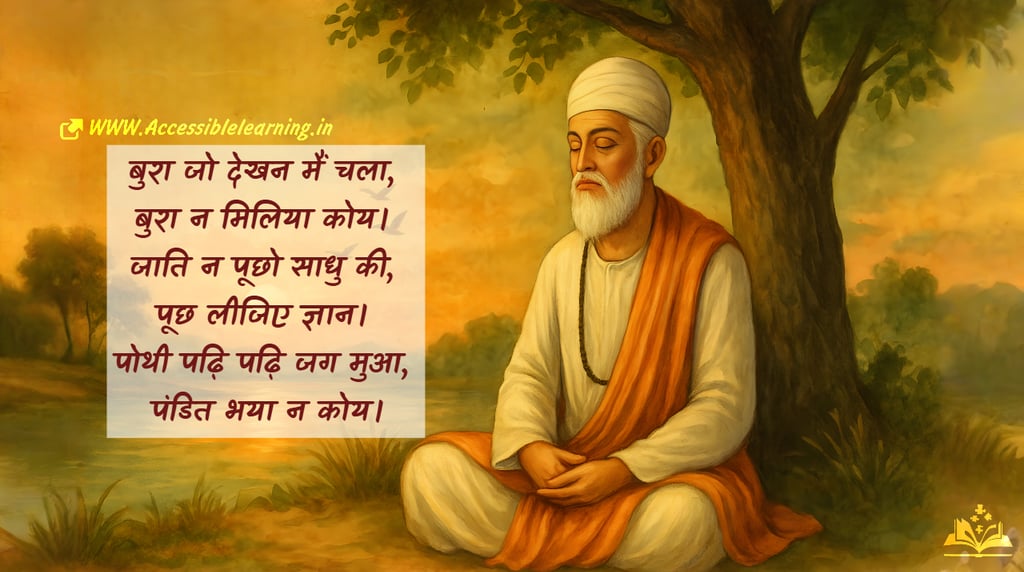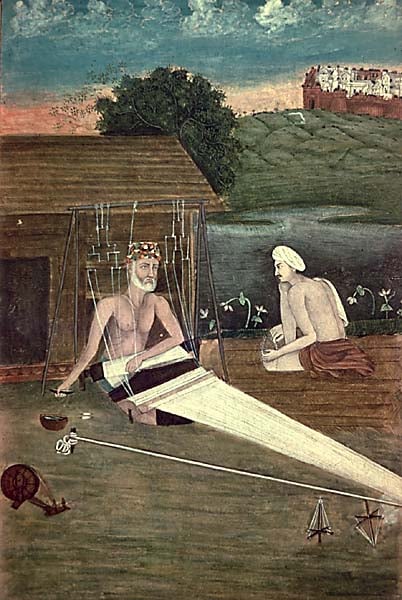
Kabirdas Jayanti: Honoring the Mystic Who Bridged Hearts and Faiths
Celebrate Kabirdas Jayanti 2025 with the life, teachings & stories of Sant Kabir Das — the mystic poet who inspired millions with his dohas, wisdom, and truth.
CULTURE/TRADITIONEVENT/SPECIALEDUCATION/KNOWLEDGEINDIA/BHARATCELEBRATION/FESTIVALS
keshav Jha
6/5/20255 min read


Kabirdas Jayanti commemorates the birth of Sant Kabir Das (संत कबीर दास), one of India’s most revered spiritual icons and poet-saints. Celebrated with devotion and reverence, this day offers a chance to reflect on Kabir’s fearless voice against social inequality, religious rigidity, and spiritual ignorance. His verses—rooted in simplicity and universal love—continue to guide millions in their spiritual and moral journeys.
When is Kabirdas Jayanti Celebrated?
Kabirdas Jayanti falls on the Jyeshtha Purnima (full moon day) in the Hindu calendar, usually in May or June. In 2025, it will be observed on June 11.
Who Was Sant Kabir Das? A Life of Mystery and Message
Sant Kabir Das was born in 1440 CE, though his exact birth details remain wrapped in legend. It is widely believed he was found floating on a lotus leaf in Lahartara Lake near Varanasi and was raised by a Muslim weaver couple, Neeru and Neema.
A Weaver by Profession, A Saint by Calling
Though born into humble surroundings, Kabir’s spiritual wisdom was profound. Working at his loom, he composed verses—dohe—that exposed the shallowness of ritual and the need for a direct connection with the Divine.
Stories from Kabir’s Life: Simple Acts, Profound Lessons
The Guru Dilemma
Kabir deeply revered Saint Ramananda, a Hindu ascetic. However, because Kabir was raised Muslim, orthodox followers opposed his initiation. To bypass this, Kabir lay on the steps of Panchganga Ghat, where Ramananda would walk. As the saint unknowingly stepped on him, he exclaimed, “Ram Ram!” Kabir later declared these divine words as his initiation mantra—blending devotion with clever simplicity.
The Brahmin’s Challenge
A proud Brahmin once mocked Kabir for not being born into a high caste. Kabir calmly replied:
“Jāti na pūchho sādhu kī, pūchh lijiye jñān;
Mol karo talvār kā, pada rahne do myān.”
Don’t ask a saint’s caste—ask about his wisdom. Judge the sword’s worth, not its sheath.


Writings of Kabir Das: A Mirror to Inner Truth
Kabir wrote in vernacular Hindi using metaphors from everyday life, making his teachings accessible to the masses.
Kabir Ke Dohe (Couplets)
Short, rhythmic two-liners with deep meaning. Example:
“Kal kare so aaj kar, aaj kare so ab;
Pal mein parlay hoyegi, bahuri karega kab?”
(What you plan to do tomorrow, do today; what you plan to do today, do now. Catastrophe can strike in a moment—when will you do it then?)
Bijak
A philosophical text compiled by Kabir Panthis, containing metaphysical poems (Sabda), dialogues (Rāmāīnī), and anecdotes (Sākhī).
Kabir Granthavali
A collection curated by the Rajasthan-based Bhakti poets that preserves Kabir's teachings in song and verse.
Kabir’s Philosophy: A Path of Devotion and Oneness
Nirgun Bhakti: Kabir believed in a formless God—beyond images, temples, and rituals.
Inner Awakening: He often spoke of the "antaratma" (inner soul) and the need to purify one’s heart.
Equality: He rejected caste, religious divisions, and male dominance, championing universal brotherhood.
Social Courage: Kabir’s verses publicly criticized both Hindu orthodoxy and Islamic dogmatism, earning admiration and persecution from both sides.
How is Kabirdas Jayanti Celebrated Today?
The Jayanti is celebrated with enthusiasm across India, especially in
Varanasi
Maghar (where he took samadhi)
Chhattisgarh and Madhya Pradesh
Common Rituals Include
Shobha Yatras (processions) with Kabir’s dohas displayed on banners.
Recitation of Bhajans and Dohas in community halls and temples.
Langars (free community meals) to spread Kabir’s message of equality.
Social campaigns on interfaith unity, literacy, and compassion.

Maghar: The Place of Liberation
Kabir chose to leave his body in Maghar, a place believed to be inauspicious for dying, to prove that liberation doesn't depend on place but purity of heart. Upon his death, both Hindus and Muslims claimed his body. According to legend, when they lifted the cloth covering him, they found only flowers, which they divided among themselves—signifying unity in diversity.
Global & Cultural Impact
His dohas are included in NCERT textbooks and academic syllabi.
He’s mentioned in the Guru Granth Sahib, reflecting his importance in Sikhism.
Kabir’s teachings are quoted by Mahatma Gandhi, Swami Vivekananda, and Osho.
His messages are now used in conflict resolution, interfaith dialogues, and even mental health education for simplicity and mindfulness.
Stories from the life of Sant Kabir Das
The Lotus Leaf & Divine Birth
According to legend, Kabir was found as an infant floating on a lotus leaf in the Lahartara Lake near Varanasi. A poor Muslim weaver couple, Neeru and Neema, adopted him. Many believe Kabir was a divine soul sent to bridge the divide between faiths.
Symbolism: Truth and divinity transcend caste and religion.
The Guru Without Initiation
Kabir longed to be accepted as a disciple by Guru Ramananda, a respected Hindu saint. However, social restrictions didn’t allow a low-caste or Muslim boy to become his student.
Determined, Kabir lay on the steps of the ghat where Ramananda bathed every day. When the Guru stepped on him unknowingly, he exclaimed, "Ram Ram!" Kabir got up joyfully and declared those words to be his initiation mantra.
Lesson: Spiritual wisdom does not require rituals; intent and surrender are enough.
Burning the Scriptures
Once, a scholar approached Kabir and criticized him for not reading sacred texts. Kabir replied:
"I have burnt my tomes and scriptures; only love now remains.
With the fire of truth I cooked my heart; that’s the food my soul sustains."He then literally threw books into a fire, declaring that experience and love are greater than blind scholarship.
Moral: Real knowledge is lived, not just read.
The King’s Challenge
A proud king once summoned Kabir, annoyed by his popularity. He questioned his knowledge, asking, “Where is your God? Show me!”
Kabir smiled and said, “He is in you just as much as in me.”The king laughed, “Then why do I not feel him?”
Kabir responded:
“Just as butter lies hidden in milk, you won’t find it without churning.
Churn your heart with love and truth, and you’ll find Him within.”The king was humbled and became a devotee.
Lesson: God is within, but realization needs churning—through meditation and love.
The Dead Cow & Caste Hypocrisy
A Brahmin once taunted Kabir: “You touch leather, you're impure! You can’t be a saint!”
Kabir smiled and said, “Oh Brahmin, if touching a dead cow makes me impure, what about your scriptures bound in leather?”
He continued:
“Don’t measure my soul by the skin I touch. Purity is not in caste, but in the heart.”
Moral: Hypocrisy can hide behind tradition; truth cuts through illusion.
Kabir’s Death—The Final Miracle
When Kabir passed away in Maghar, both Hindus and Muslims fought over his body. Hindus wanted to cremate him; Muslims wanted to bury him. When the cloth covering Kabir’s body was lifted—only fragrant flowers lay beneath.
Each group took half and performed their rites—a final message of unity from the saint who spent his life dissolving boundaries.
Symbolism: Love has no religion. Truth belongs to all.
The Ego of a Disciple
One of Kabir’s disciples started claiming he had become as wise as the master. Kabir gave him a needle and told him to bury it under a tree so it could be used in the afterlife.
Confused, the disciple asked, “How will I retrieve it after death?”
Kabir replied:
“If you can’t carry a needle, how will you carry ego?”
Moral: Even subtle pride keeps the soul from liberation.
God in a Drop
Someone asked Kabir, “Can God live in such a small heart as mine?”
Kabir picked up a water droplet and said, “See this? The whole moon lives in it.”
Meaning: Even the smallest heart can hold the infinite if it’s pure and open.
As we celebrate Kabirdas Jayanti, we are reminded of a soul who lived with simplicity and spoke with the fire of truth. Kabir Das showed us that God is not bound by temples or mosques—He resides within every being. His dohas continue to guide seekers, poets, and philosophers alike, offering insight into the divine and the self.
In today’s complex world, Kabir’s voice still echoes through the centuries:
“Bura jo dekhan main chala, bura na milya koi;
Jo mann khoja aapna, mujhse bura na koi.”
Let this Jayanti be more than ritual—let it be a reflection, a renewal, and a return to the soul’s eternal truth.
Subscribe To Our Newsletter
All © Copyright reserved by Accessible-Learning Hub
| Terms & Conditions
Knowledge is power. Learn with Us. 📚


